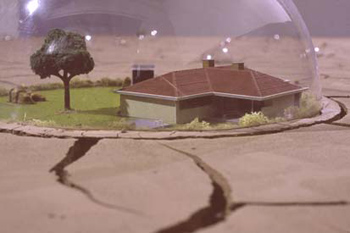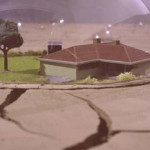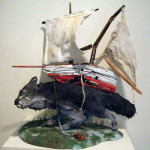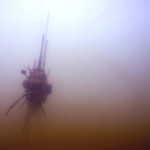By MATTHEW NASH
It's hard to be optimistic about the apocalypse, yet much of the work in the group exhibition "After The End Of The World" feels, well… almost optimistic. The four artists in this exhibition each create worlds that imply the end of days, and yet each also finds humor, beauty and even hope in the gloomy visions they create. This is one of the most upbeat and lighthearted apocalypse-themed shows I think I have ever seen.
Joshua R. Marks Virus installation dominates much of the space, and sets the initial tone for reading the other works. This sprawling diorama presents a parched and arid desert, dimpled with glass domes that each contain lush green grass and the amenities of civilization. In the largest dome is a suburban-style home, while smaller domes feature a single tree, or a small stretch of white picket fence. Unlike most end-of-the-world imaginings, Marks' focus on these mundane, domestic details cause one to think less of the destruction that created the desert, and more about the mindset of the family who must live within the dome and find ways of living a normal life.
Nearby, the sculptures of Andy Rosen present epic struggles and moments of personal triumph or tragedy. In one piece, a tiny creature, half-insect and half-human, stands in triumph on top of a mountain peak. Attached to its back is a red Swiss Army knife larger than the creature that carries it. The pose of the creature, and the obvious burden of the knife, imply that its ascent was a difficult one, and it is proud to stand atop the mountain.
Rosen's I Can Only Take You So Far is, however, far more tragic. This piece depicts a wolf bearing a broken ship on its back. The wolf is obviously straining and near collapse, and the boat appears near ruin. The wolf's head turns slightly, as if it is addressing the unseen passengers of the boat, speaking the title of the piece before laying down to die. In the context of the rest of the show, is this wolf a representation of some larger force, a furry Atlas, bearing the weight of our little boat of a world? Or, is this a vision of a future in which giant wolves roam the world, carry boats full of burdensome passengers, and speak wisely?
Alongside the relatively narrative sculptural pieces, the photos of Bennett Morris offer a more serious and abstracted vision. In his images, objects and forms emerge from a misty, diffuse fog. Some appear to be ships or buildings of various sorts, others might be the last rusting remnants of a long-lost culture.
Morris' images occupy a strange place within the rest of the show. Surrounded by elements of domesticity, evolution, mutation and pop culture, each of his images becomes mingled with these external ideas. One image, for example, appears to be the drone sentry emerging from the snow in the opening scenes of The Empire Strikes Back. Yet, how much of this reading is influenced by Scott Listfield's painting Rock The Casbah that faces it?
Perhaps the most intriguing and startling aspect of Morris' images is how much they evoke the dust-diffused photographs taken on September 11th, and that some of his oddly displaced structures look so much like the remnants of the towers in the smoke. To imagine a future in which that tragedy is repeated on a large scale is terrifying.
The fourth artist included in this exhibition is Scott Listfield, whose paintings of a lone astronaut traveling through the world I havewritten about before. Here, though, Listfield's paintings take on a darker tone than I have experienced before. Not that the images themselves have changed – each of the paintings shown here have exhibited previously – but it is the context that causes them to read differently. While frequently I have experienced the astronaut as a form of narrator, guiding the viewer through his vision of a future world in which pop culture, art and life all collide, within this exhibition it's hard not to think of him as trapped within his suit, a victim of the future he inhabits. Rather than appearing as a curious naïf exploring the world, he seems to be removed from it, contained within the spacesuit that keeps him alive.
This was, for me, one of the great joys of seeing the work of these four artists in one exhibition. Their influences on each other, and how their imagery and narratives are perceived, is very apparent in Jeff Badger's curatorial work. As a vision of the future it is full of fantasy and humor, but also beauty and some touching moments of humanity.
- Joshua R. Marks, Virus (detail), mixed media installation
- Andy Rosen, I Can Only Take You So Far, mixed media
- Bennett Morris, Inquest model 06v01, digital photo
"After the End of the World" is on view September 14 - November 3, 2007 at Whitney Art Works in Portland, ME.
All images are courtesy of the artist and Whitney Art Works.







